

Tonga reported its first outbreak after the virus arrived with international aid vessels following the Jan. it's likely to hit them for the next year or so at least," said Katie Greenwood, head of the Red Cross Pacific delegation. The world has seen more than 445 million confirmed COVID-19 cases, and new weekly cases have been declining recently in all regions except the Western Pacific, which includes China, Japan and South Korea, among others, the World Health Organization reported this week.Īlthough the overall figures in the Pacific islands seeing their first outbreaks are small compared to larger countries, they are significant among their tiny populations and threaten to overwhelm fragile health care systems. The United States has the biggest official death toll in the world, but the numbers have been trending downward over the last month. "In some, mostly rich countries, that fraction is high and the official tally can be considered to be fairly accurate, but in others it is highly underestimated." Geographic disparities still sharp "Confirmed deaths represent a fraction of the true number of deaths due to COVID, mostly because of limited testing, and challenges in the attribution of the cause of death," Mathieu told The Associated Press. Poor record-keeping and testing in many parts of the world has led to an undercount in coronavirus deaths, in addition to excess deaths related to the pandemic but not from actual COVID-19 infections, like people who died from preventable causes but could not receive treatment because hospitals were full.Įdouard Mathieu, head of data for the Our World in Data portal, said that, when countries' excess mortality figures are studied, as many as nearly four times the reported death toll have likely died because of the pandemic.Īn analysis of excess deaths by a team at The Economist estimates that the number of COVID-19 deaths is between 14.1 million and 23.8 million. Now it has reached 6 million - more than the populations of Berlin and Brussels combined, or the entire state of Maryland.īut despite the enormity of the figure, the world undoubtedly hit its 6 millionth death some time ago. Four months later another million people had died, and 1 million have died every three months since, until the death toll hit 5 million at the end of October. It took the world seven months to record its first million deaths from the virus after the pandemic began in early 2020. "The large majority of the deaths and the severe cases are in the unvaccinated, vulnerable segment of the population."



"This is a disease of the unvaccinated - look what is happening in Hong Kong right now - the health system is being overwhelmed," said Pang, the former director of research policy and cooperation with the World Health Organization. And despite its wealth and vaccine availability, the United States is nearing 1 million reported deaths on its own.ĭeath rates worldwide are still highest among people unvaccinated against the virus, said Tikki Pang, a visiting professor at the National University of Singapore's medical school and co-chair of the Asia Pacific Immunization Coalition.


 0 kommentar(er)
0 kommentar(er)
